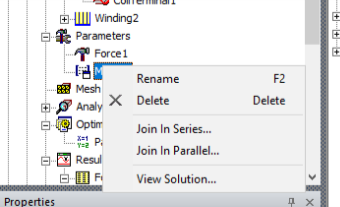-
-
November 13, 2021 at 10:30 pm
S78MALIK
SubscriberI have two concentric coils, carrying currents in the opposite directions from each other. I create cross-sections and assign coil terminals to them (in the opposite directions), and add them to a winding. My results have been inconclusive so far. The inductance values obtained from the "Matrix" in an "eddy-current module" gives me a value which does not seem right. I even tried increasing the number of adaptive passes for the convergence to a finer mesh, but it's the same thing.
Just yesterday, I discovered "Join in series" and "Join in parallel" options when I right clicked "Matrix", which gave me the ability to join multiple windings in series/parallel.
November 17, 2021 at 2:50 pmNavya Chode
Forum ModeratorHi @S78MALIK In your model since both the coils are not physically connected. Adding each of them to a separate winding is enough. You need not select join in parallel or series.
After the matrix computation, you will get self, mutual and leakage inductance values in the results.
When you say "value which does not seem right" - What are you comparing the results with?
I don't know how did you set up everything in the model.
If multiple coils are added to a winding, Maxwell assumes all those coils are connected in series.
Regards Navya
November 24, 2022 at 5:37 amJason C
SubscriberHi @Navya,
Could you tell me how to parallel the current source in Maxwell 3D eddy current solver?
I have a transformer and I want to parallel the secondary side, but I don't know how to parallel it.
Viewing 2 reply threads- The topic ‘In Ansys Maxwell 3D, do we need to use the “Join in series” or “Join in parallel” options?’ is closed to new replies.
Ansys Innovation SpaceTrending discussions- Y wiring method and the start and end points of winding.
- Lumped Port Deembed
- Optimizing Via Impedance in Ansys HFSS 3D Layout Using Geometric Parameter Sweep
- HFSS libnvidia-ml.so too old or could not be found – Warning in slurm job output
- Hfss 3D pcb via capped and filled with epoxy
- AEDT Natural Convection with default correlation is failing solver initializatio
- Three-Phase Voltage Imbalances in dual stator electric generator
- STL Import Errors in HFSS After Cleaning in SpaceClaim
- Calc Error in Field Calculator after PyAEDT Analyze
- import file autocad 3d
Top Contributors-
3907
-
1414
-
1256
-
1118
-
1015
Top Rated Tags© 2025 Copyright ANSYS, Inc. All rights reserved.
Ansys does not support the usage of unauthorized Ansys software. Please visit www.ansys.com to obtain an official distribution.
-


Ansys Assistant

Welcome to Ansys Assistant!
An AI-based virtual assistant for active Ansys Academic Customers. Please login using your university issued email address.
Hey there, you are quite inquisitive! You have hit your hourly question limit. Please retry after '10' minutes. For questions, please reach out to ansyslearn@ansys.com.
RETRY








